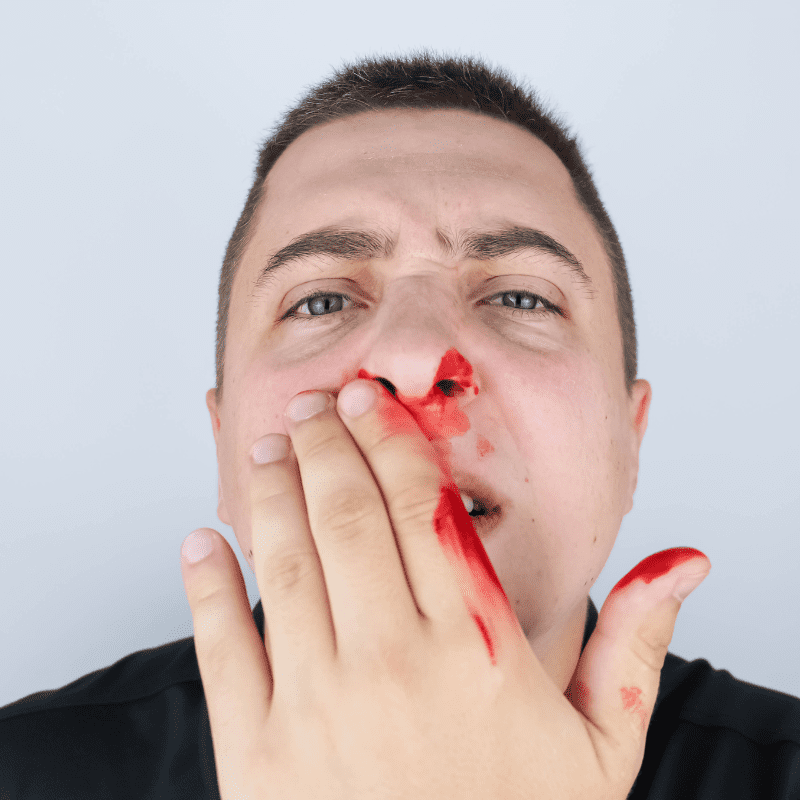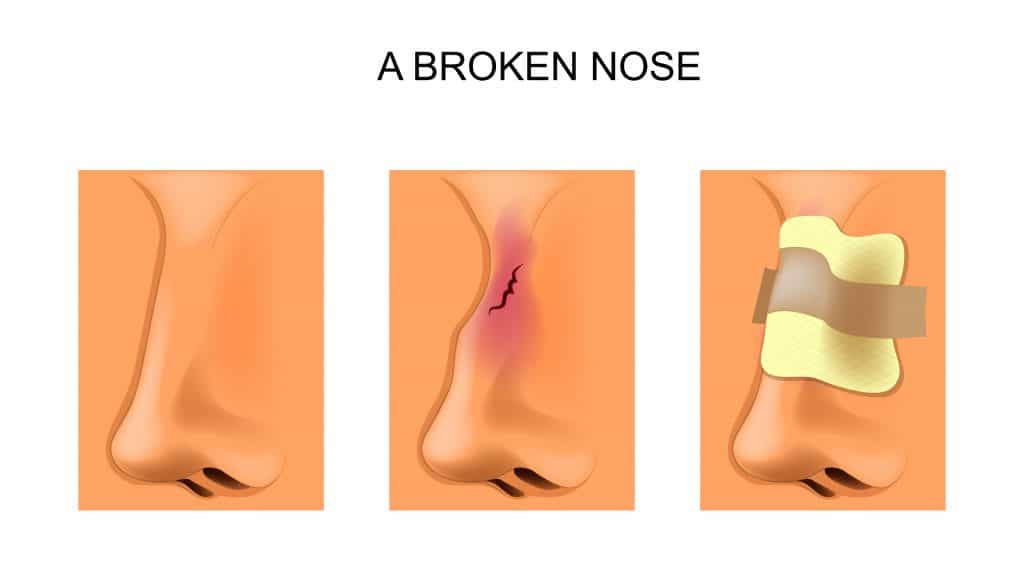Nasal Fracture and Treatment Coding Challenge

The Coding Challenge
Question:
A 16-year-old male is seen in the ED with complaints of pain and difficulty breathing through his nose. He states he was playing basketball at his high school earlier when another player accidentally elbowed him in the mid-face area. After clinical examination, the physician diagnoses a nasal bone fracture. The nose is successfully realigned through closed reduction, and internal packing is applied to control the bleeding. The patient is referred to an ENT specialist for follow-up care. Assign for CPT and ICD-10-CM.
A. 21354, S02.2XXB, Y04.2XXA, Y93.67, Y92.212
B. 21315-54, S02.2XXA, W51.XXXA, Y93.67, Y92.213
C. 21337, M84.68XA, Y04.2XXA, Y93.67, Y92.212
D. 21320-54, S02.2XXA, Y04.2XXA, Y93.67, Y92.213
Answer:
B. 21315-54, S02.2XXA, W51.XXXA, Y93.67, Y92.213
Nasal Bone Fractures
Nasal fractures are common injuries that often occur during contact sports, mostly in males. A nasal fracture can involve the bone or cartilage over the nose or in the septum. In this case, the patient sustained blunt trauma to the nose, causing a nasal bone fracture.
Common symptoms of a broken nose include a nosebleed (epistaxis), pain (algia) and swelling (edema) around the nose, difficulty breathing (dyspnea), and nasal discharge (mucus).
Other terms used to describe a nasal bone fracture are broken nose, nose fracture, nasal fracture, and nasal septal fracture.
ED stands for emergency department.

CPT Coding
Closed reduction was performed to realign or reset the nasal bone fracture. No incision was made in the skin. Codes for fracture and/or dislocation procedures on the head are located in the musculoskeletal system subsection of Surgery.
Methods used for closed treatment of nasal fractures include without manipulation or stabilization; with manipulation and without stabilization; with manipulation and with stabilization.
In CPT, “manipulation” means reduction. Internal packing may be used to control any post-operative bleeding. Stabilization involves using an external splint to keep the nose’s new shape and protect it while healing.
Locate and Verify
In the CPT Index, look up Nose/fracture treatment/closed, 21310-21320, 21337, 21345. We can then go to the Tabular List and verify the correct code as:
21315, Closed treatment of nasal bone fracture with manipulation; without stabilization
Note: CPT code 21310, Closed treatment of nasal bone fracture without manipulation, has been deleted. This type of procedure is now reported with an appropriate E/M code.
CPT code 21315 needs a modifier. Why? Because the ED physician performed only the closed reduction. They then referred the patient to an ENT specialist for follow-up care. Therefore, modifier 54 (surgical care only) must be appended to the CPT code, making it 21315-54.
According to CPT, the definition for modifier 54 (Surgical Care Only) is:
“When one physician or other qualified health care professional performs a surgical procedure, and another provides preoperative and/ or postoperative management, surgical services may be identified by adding modifier 54 to the surgical procedure code.”
ICD-10-CM Coding
A traumatic fracture is different from a pathological fracture. A traumatic fracture happens when significant or extreme force is applied to a bone. A pathological fracture, or nontraumatic fracture, is a break in a bone that is due to bone disease or a change surrounding the bone tissue that causes the bone to weaken.
Codes for traumatic fractures are reported with codes from Chapter 19. Injury, poisoning and certain other consequences of external causes (S00-T88). Pathological fractures are reported with codes from Chapter 13. Diseases of the musculoskeletal system and connective tissue (M00-M99).
Locate and Verify – Fracture
In the ICD-10-CM Alphabetic Index, look up Fracture, traumatic (abduction) (adduction) (separation)/nose, nasal (bone) (septum), S02.2. In the Tabular List, we can verify the correct code as:
S02.2XXA, Fracture of nasal bones, initial encounter for closed fracture
The documentation does not state if the fracture is open or closed; hence, the fracture should be coded as closed. A closed fracture means the bone is broken, but there is no puncture or open wound in the skin. An open fracture means it is open to the air.
A closed fracture does not mean the treatment is closed. Likewise, an open fracture does not mean the treatment is open.
The 7th character “A” (initial encounter) is to be used to show the patient is receiving active treatment for the fracture.
Locate and Verify – External Cause Codes
External cause codes are supplemental codes to diagnosis codes found in chapters 1-19 of ICD-10-CM. External cause codes are never sequenced first in non-inpatient settings.
External cause codes are located in the External Cause of Injuries Index. They capture how the injury or health condition happened (cause), intent (intentional or accidental, or intentional, such as suicide or assault), the place of occurrence, the activity of the patient at the time of the event, and the person’s status (such as civil or military).
Based on the documentation for the above scenario, we need to code for the following:
Cause and Intent: accidental elbow to the mid-face area.
Look up bumping against, into (accidentally)/person (s), W51. In the Tabular List, we can verify the correct code as:
W51.XXXA, Accidental striking against or bumped into by another person, initial encounter
Again, the 7th character “A” is used because the patient is receiving active treatment.
Activity: basketball.
Look up Activity (involving) (of victim at time of event)/basketball Y93.67. This code can be verified in the Tabular List as:
Y93.67, Activity, basketball
Place of occurrence: high school.
Look up Place of occurrence/school (private) (public) (state)/high school Y92.213. This code can be verified in the Tabular List as:
Y92.213, High school as the place of occurrence of the external cause
So, our four ICD-10-CM codes are S02.2XXA, W51.XXXA, Y93.67, and Y92.213.
Incorrect Answers
A, C, and D are incorrect.
A. 21354, S02.2XXB, Y04.2XXA, Y93.67, Y92.212. Correct CPT code, but it is missing modifier 54. S02.2XXB refers to Fracture of nasal bones, initial encounter for open fracture. Y04.2XXA refers to Assault by strike against or bumped into by another person, initial encounter. Y92.212 refers to Middle school as the place of occurrence of the external cause.
C. 21337, M84.68XA, Y04.2XXA, Y93.67, Y92.212. 21337 refers to Closed treatment of nasal septal fracture, with or without stabilization. M84.68XA refers to Pathological fracture in other disease, other site, initial encounter for fracture. Y04.2XXA refers to Assault by strike against or bumped into by another person, initial encounter. Y92.212 refers to Middle school as the place of occurrence of the external cause.
D. 21320-54, S02.2XXA, Y04.2XXA, Y93.67, Y92.213. 21320 refers to Closed treatment of nasal bone fracture with manipulation; with stabilization. Y04.2XXA refers to Assault by strike against or bumped into by another person, initial encounter.

Related
- Name That Code – Bimalleolar Ankle Fracture
- Rib Fractures With Flail Chest and ORIF Coding
- Osteoporotic Compression Fractures: Medical Terminology Challenge
- Strengthen Your Vertebroplasty and Kyphoplasty Coding Skills
- External Cause Codes: Bite from the Angry Dog
- Suffixes Indicating Procedure: Medical Terminology Challenge